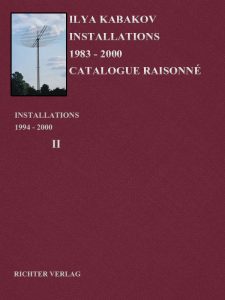The Globe in a Different Topographical System
with Emilia Kabakov
YEAR: 1999
CATALOG NUMBER: 145
PROVENANCE
The artist
1999, Collection Weisman Art Museum, Minneapolis
EXHIBITIONS
Minneapolis, Frederick R. Weisman Art Museum
World Views: Maps & Art, 11 Sep 1999 — 2 Jan 2000
DESCRIPTION
The installation consists of three parts:
A structure is built in the corner and then covered with peat (see sketch). A map is placed under glass for each ‘step.’ A map of North America is placed on the upper step, of Europe on the middle one, and of Russia on the lower one. The maps should be in color.
A semi-circular table must be built, and texts and explanatory sketches should be placed on it under plexiglass.
A staircase must be built and placed next to the structure, so that in the first place, one can climb up it and see all the maps from above, and in the second place, which is especially important, the viewer standing up above will have a certain sensation like the flight of a cosmonaut, viewing the entire ‘earthly’ situation ‘from outside’ and seeing the earth in a new, different (graduated) perspective, and not as traditionally spherical.
CONCEPT OF THE INSTALLATION
As is well known, the Earth is round, as was first predicted and then confirmed by sea and air travelers. Here we shall call it ‘simple’ geography. The various countries of the world directly adjoin one another, being arranged, so to speak, flatly over the entire surface of the ‘globe’ (obviously, differing from one another in terms of mountain height, relief, etc.). But the ‘geography’ which will be discussed here cannot be verified with topographical or other physical measurements. This ‘geography’ can best be called ‘mental’ or psychological, and although there doesn’t exist a physical means for measuring it yet, it is no less cogent or probable than the geography of the new era, even though it is relatively recent.
Functioning as the objects of correlation in this ‘mental’ geography are not continents, but rather such mental spaces as (in the case analyzed by us) Russia, Europe, North America (the author doesn’t have a sufficiently clear impression of other spaces). All of these three ‘worlds’ are located in relation to one another, like three steps in a flight of stairs. In this system, it is precisely Europe – the middle step – that can be called the ‘earth’ in the commonly known sense of that word: it has an old history, it is deeply rooted in the past, it can be called the world of traditional human habitation, the world of ‘earthly life.’ Russia, in relation to Europe, exists as a gigantic drop ‘downward’ in relation to the surface plane of Europe, of 1,000 and perhaps more kilometers downward. Thus it is separated from Europe by a vertical wall dropping downward. We could talk a great deal and in detail about the nature of forms of life in that ‘drop,’ but they are all inherent in mysterious, prehistoric forms, as opposed to the forms found in ‘land of people’ (Europe). Colonists descending downward have attempted to assimilate this area of drop off for a long time, but they have been unsuccessful.
In this system, America occupies the third step, and as far as Russia descends downward under the earth to a depth of 1,000 kilometers, that’s how far America is raised above the earth over Europe. Life in America, in essence, is life in the cosmos; that is, like inside a flying rocket ship. Even though in America there are multitudes of mountains, earth, lakes, these are a different earth, different mountains. This ‘earth’ is somewhere infinitely high above and distinct from the ‘standing earth’ of Europe. This America is incessantly ‘rushing’ in space along an enormous ‘unearthly’ trajectory, communicating a special supplemental energy and sensation of unheard-of speed of motion to all the inhabitants, precisely like inside the cabin of a gigantic spaceship. The cosmos, the cosmic ascent upward, this is what, in contrast to Russia, a person feels during a flight from Europe ‘upward’ to America.
The knowledge and consideration of this ‘topography’ will help many travellers of these regions to explain and overcome their negative experiences which are inevitably linked to such travels, or to a definitive move from one of these regions to another.
Images
Literature



